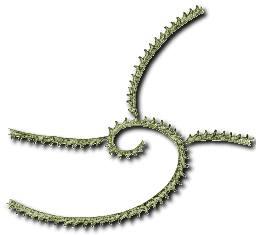Geology / Gallery

Cyrtograptus murchisoni (6)
The Cyrtograptus group of graptolites are unusual in Monograptidae for developing a spiral form. Most monograptids had a straight form : resembling hack saw blades and when preserved in slate can be mistaken at a distance as chalk marks. The name graptolite stems from their appearance as marks in stone from the two Greek words 'stone' and 'write'. This family was one of the last major divisions of the graptolites to evolve, before the whole group became extinct at the end of the Devonian.
The graptolite is named after the pioneering geologist who first identified this fossil as a new species : Sir Roderick Murchison ➚. It was Sir Roderick who first worked out the main divisions of the Silurian system.
Cyrtograptus murchisoni lived in the middle Wenlock series of the Silurian.
| Division | Name |
| Phylum | Hemichordata |
| Class | Graptolithina |
| Order | Graptoloidea |
| Suborder | Virgellina |
| Family | Monograptidae |
Fossil gallery
- Brittle Star : Lapworthia miltoni
- Trilobite : Dalmanites myops
- Crinoid : Eucalyptocrinites decorus
- Gastropod : Poleumita discorus
- Trilobite : Calymene blumenbachi
- Graptolite : Cyrtograptus murchisoni
- Sponge : Ischadites koenigi
- Conodont : Ozarkodina typica
- Brachiopod : Pentamerus oblongus
- Graptolite : Petalograptus minor
- Brachiopod : Chonetes striatellus
- Cystoid : Lepocrinetes quadrifasciatus
- Bivalve : Pteronitella retroflexa
- Graptolite : Monograptus lobiferus
- Gastropod : Platyceras haliotis
- Crinoid : Sagenocrinites expansus
- Brachiopod : Atrypa reticularis
